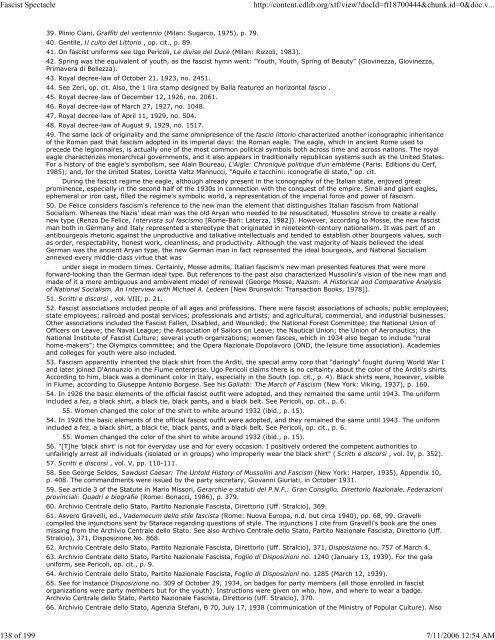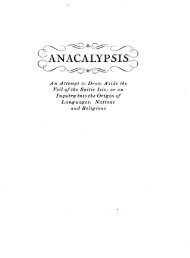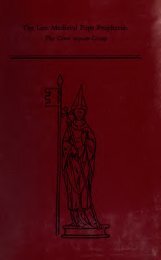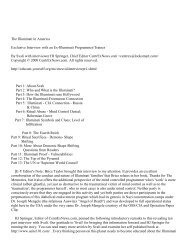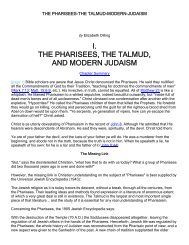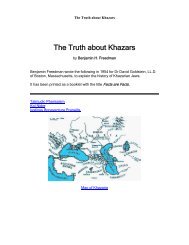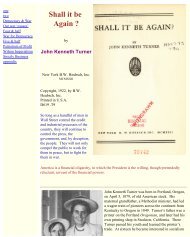You also want an ePaper? Increase the reach of your titles
YUMPU automatically turns print PDFs into web optimized ePapers that Google loves.
<strong>Fascist</strong> <strong>Spectacle</strong> http://content.cdlib.org/xtf/view?docId=ft18700444&chunk.id=0&doc.v...<br />
39. Plinio Ciani, Graffiti del ventennio (Milan: Sugarco, 1975), p. 79.<br />
40. Gentile, Il culto del Littorio , op. cit., p. 89.<br />
41. On fascist uniforms see Ugo Pericoli, Le divise del Duce (Milan: Rizzoli, 1983).<br />
42. Spring was the equivalent of youth, as the fascist hymn went: "Youth, Youth, Spring of Beauty" (Giovinezza, Giovinezza,<br />
Primavera di Bellezza).<br />
43. Royal decree-law of October 21, 1923, no. 2451.<br />
44. See Zeri, op. cit. Also, the 1 lira stamp designed by Balla featured an horizontal fascio .<br />
45. Royal decree-law of December 12, 1926, no. 2061.<br />
46. Royal decree-law of March 27, 1927, no. 1048.<br />
47. Royal decree-law of April 11, 1929, no. 504.<br />
48. Royal decree-law of August 9, 1929, no. 1517.<br />
49. The same lack of originality and the same omnipresence of the fascio littorio characterized another iconographic inheritance<br />
of the Roman past that fascism adopted in its imperial days: the Roman eagle. The eagle, which in ancient Rome used to<br />
precede the legionnaires, is actually one of the most common political symbols both across time and across nations. The royal<br />
eagle characterizes monarchical governments, and it also appears in traditionally republican systems such as the United States.<br />
For a history of the eagle's symbolism, see Alain Boureau, L'Aigle: Chronique politique d'un emblème (Paris: Editions du Cerf,<br />
1985); and, for the United States, Loretta Valtz Mannucci, "Aquile e tacchini: iconografie di stato," op. cit.<br />
During the fascist regime the eagle, although already present in the iconography of the Italian state, enjoyed great<br />
prominence, especially in the second half of the 1930s in connection with the conquest of the empire. Small and giant eagles,<br />
ephemeral or iron cast, filled the regime's symbolic world, a representation of the imperial force and power of fascism.<br />
50. De Felice considers fascism's reference to the new man the element that distinguishes Italian fascism from National<br />
Socialism. Whereas the Nazis' ideal man was the old Aryan who needed to be resuscitated, Mussolini strove to create a really<br />
new type (Renzo De Felice, Intervista sul fascismo [Rome-Bari: Laterza, 1982]). However, according to Mosse, the new fascist<br />
man both in Germany and Italy represented a stereotype that originated in nineteenth-century nationalism. It was part of an<br />
antibourgeois rhetoric against the unproductive and talkative intellectuals and tended to establish other bourgeois values, such<br />
as order, respectability, honest work, cleanliness, and productivity. Although the vast majority of Nazis believed the ideal<br />
German was the ancient Aryan type, the new German man in fact represented the ideal bourgeois, and National Socialism<br />
annexed every middle-class virtue that was<br />
under siege in modern times. Certainly, Mosse admits, Italian fascism's new man presented features that were more<br />
forward-looking than the German ideal type. But references to the past also characterized Mussolini's vision of the new man and<br />
made of it a more ambiguous and ambivalent model of renewal (George Mosse, Nazism: A Historical and Comparative Analysis<br />
of National Socialism. An Interview with Michael A. Ledeen [New Brunswick: Transaction Books, 1978]).<br />
51. Scritti e discorsi , vol. VIII, p. 21.<br />
52. <strong>Fascist</strong> associations included people of all ages and professions. There were fascist associations of schools; public employees;<br />
state employees; railroad and postal services; professionals and artists; and agricultural, commercial, and industrial businesses.<br />
Other associations included the <strong>Fascist</strong> Fallen, Disabled, and Wounded; the National Forest Committee; the National Union of<br />
Officers on Leave; the Naval League; the Association of Sailors on Leave; the Nautical Union; the Union of Aeronautics; the<br />
National Institute of <strong>Fascist</strong> Culture; several youth organizations; women fasces, which in 1934 also began to include "rural<br />
home-makers"; the Olympics committee; and the Opera Nazionale Dopolavoro (OND, the leisure time association). Academies<br />
and colleges for youth were also included.<br />
53. Fascism apparently inherited the black shirt from the Arditi, the special army corp that "daringly" fought during World War I<br />
and later joined D'Annunzio in the Fiume enterprise. Ugo Pericoli claims there is no certainty about the color of the Arditi's shirts.<br />
According to him, black was a dominant color in Italy, especially in the South (op. cit., p. 4). Black shirts were, however, visible<br />
in Fiume, according to Giuseppe Antonio Borgese. See his Goliath: The March of Fascism (New York: Viking, 1937), p. 160.<br />
54. In 1926 the basic elements of the official fascist outfit were adopted, and they remained the same until 1943. The uniform<br />
included a fez, a black shirt, a black tie, black pants, and a black belt. See Pericoli, op. cit., p. 6.<br />
55. Women changed the color of the shirt to white around 1932 (ibid., p. 15).<br />
54. In 1926 the basic elements of the official fascist outfit were adopted, and they remained the same until 1943. The uniform<br />
included a fez, a black shirt, a black tie, black pants, and a black belt. See Pericoli, op. cit., p. 6.<br />
55. Women changed the color of the shirt to white around 1932 (ibid., p. 15).<br />
56. "[T]he 'black shirt' is not for everyday use and for every occasion. I positively ordered the competent authorities to<br />
unfailingly arrest all individuals (isolated or in groups) who improperly wear the black shirt" ( Scritti e discorsi , vol. IV, p. 352).<br />
57. Scritti e discorsi , vol. V, pp. 110-111.<br />
58. See George Seldes, Sawdust Caesar: The Untold History of Mussolini and Fascism (New York: Harper, 1935), Appendix 10,<br />
p. 408. The commandments were issued by the party secretary, Giovanni Giuriati, in October 1931.<br />
59. See article 3 of the Statute in Mario Missori, Gerarchie e statuti del P.N.F.: Gran Consiglio, Direttorio Nazionale, Federazioni<br />
provinciali: Quadri e biografie (Rome: Bonacci, 1986), p. 379.<br />
60. Archivio Centrale dello Stato, Partito Nazionale <strong>Fascist</strong>a, Direttorio (Uff. Stralcio), 369.<br />
61. Asvero Gravelli, ed., Vademecum dello stile fascista (Rome: Nuova Europa, n.d. but circa 1940), pp. 68, 99. Gravelli<br />
compiled the injunctions sent by Starace regarding questions of style. The injunctions I cite from Gravelli's book are the ones<br />
missing from the Archivio Centrale dello Stato. See also Archivo Centrale dello Stato, Partito Nazionale <strong>Fascist</strong>a, Direttorio (Uff.<br />
Stralcio), 371, Disposizione No. 868.<br />
62. Archivio Centrale dello Stato, Partito Nazionale <strong>Fascist</strong>a, Direttorio (Uff. Stralcio), 371, Disposizione no. 757 of March 4.<br />
63. Archivio Centrale dello Stato, Partito Nazionale <strong>Fascist</strong>a, Foglio di Disposizioni no. 1240 (January 13, 1939). For the gala<br />
uniform, see Pericoli, op. cit., p. 9.<br />
64. Archivio Centrale dello Stato, Partito Nazionale <strong>Fascist</strong>a, Foglio di Disposizioni no. 1285 (March 12, 1939).<br />
65. See for instance Disposizione no. 309 of October 29, 1934, on badges for party members (all those enrolled in fascist<br />
organizations were party members but for the youth). Instructions were given on who, how, and where to wear a badge.<br />
Archivio Centrale dello Stato, Partito Nazionale <strong>Fascist</strong>a, Direttorio (Uff. Stralcio), 370.<br />
66. Archivio Centrale dello Stato, Agenzia Stefani, B 70, July 17, 1938 (communication of the Ministry of Popular Culture). Also<br />
138 of 199 7/11/2006 12:54 AM


